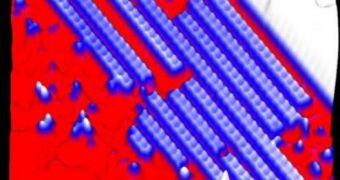A group of physicists from the Ohio University, in Athens (OUA), announces the discovery of the world's smallest known superconductor. These are materials that can transport electricity flawlessly, and without loss. Electrons placed inside them keep their flow undisturbed for a very long time, so, superconductors promise to promote innovation in a considerable number of applications. That is why the discovery made by the OUA team is so important. The type of superconductor it found is made up of four pairs of molecules, organized in a sheet less than a nanometer wide.
According to the paper the team published, this new investigation may have just laid the foundations of a new field of research in nanotechnology, which could deal with the production of highly advanced molecular superconducting nanowires from now on, for a vast array of practical applications. Nanoscale electronic devices could become feasible as well, the group says. Details of the investigation appear in the March 28 advanced issue of the esteemed scientific publication Nature Nanotechnology.
“Researchers have said that it's almost impossible to make nanoscale interconnects using metallic conductors because the resistance increases as the size of wire becomes smaller. The nanowires become so hot that they can melt and destruct. That issue, Joule heating, has been a major barrier for making nanoscale devices a reality,” OUA Nanoscale and Quantum Phenomena Institute Associate Professor of Physics and Astronomy Saw-Wai Hla, who has also been the lead author of the new journal entry, explains about the challenges the team had to face.
The molecular superconducting properties were discovered in a chemical called (BETS)2-GaCl4, which is a kind of organic salt. The trait only appears when it is placed on a silver substrate. The superconductivity was discovered as the team investigated molecular chains within the salt using an imaging method called scanning tunneling spectroscopy (STS). The molecules themselves were cooled at just ten degrees Kelvin. Generally, even at the macroscale, materials capable of exhibiting this characteristic need to be cooled to extremely low temperatures in order for it to become apparent.
“But we've opened up a new way to understand this phenomenon, which could lead to new materials that could be engineered to work at higher temperatures. This is also vital if one wants to fabricate nanoscale electronic circuits using organic molecules,” Hla concludes. Funding for the investigation came from the US Department of Energy (DOE).

 14 DAY TRIAL //
14 DAY TRIAL //